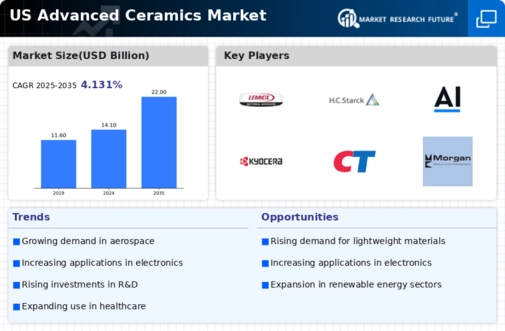The advanced ceramics market is characterized by a dynamic competitive landscape, driven by innovation, technological advancements, and increasing demand across various sectors such as electronics, aerospace, and healthcare. Key players like 3M Company (US), Kyocera Corporation (JP), and Saint-Gobain (FR) are at the forefront, each adopting distinct strategies to enhance their market positioning. 3M Company (US) focuses on innovation and product development, particularly in high-performance ceramics, while Kyocera Corporation (JP) emphasizes regional expansion and partnerships to strengthen its supply chain. Saint-Gobain (FR) is actively pursuing sustainability initiatives, which align with the growing demand for eco-friendly materials, thereby shaping the competitive environment through a commitment to responsible manufacturing practices.
The business tactics employed by these companies include localizing manufacturing to reduce lead times and optimize supply chains. The market structure appears moderately fragmented, with several players vying for market share. However, the collective influence of major companies like 3M Company (US) and Kyocera Corporation (JP) suggests a trend towards consolidation, as these firms leverage their resources to enhance operational efficiencies and market reach.
In October 2025, 3M Company (US) announced a strategic partnership with a leading aerospace manufacturer to develop advanced ceramic components for next-generation aircraft. This collaboration is poised to enhance 3M's position in the aerospace sector, allowing it to leverage its expertise in high-performance materials while addressing the increasing demand for lightweight and durable components in aviation.
In September 2025, Kyocera Corporation (JP) unveiled a new manufacturing facility in the Midwest, aimed at increasing production capacity for advanced ceramics. This move not only signifies Kyocera's commitment to meeting the growing demand in North America but also reflects a strategic effort to localize production, thereby reducing transportation costs and improving supply chain resilience.
In August 2025, Saint-Gobain (FR) launched a new line of eco-friendly advanced ceramics designed for use in the electronics sector. This initiative underscores the company's focus on sustainability and innovation, catering to the rising consumer preference for environmentally responsible products. By integrating sustainable practices into its product offerings, Saint-Gobain is likely to enhance its competitive edge in a market increasingly driven by environmental considerations.
As of November 2025, current competitive trends in the advanced ceramics market include a pronounced shift towards digitalization, sustainability, and the integration of artificial intelligence in manufacturing processes. Strategic alliances are becoming increasingly vital, as companies seek to pool resources and expertise to navigate the complexities of the market. Looking ahead, competitive differentiation is expected to evolve, with a greater emphasis on innovation and technology rather than solely on price. The ability to deliver reliable supply chains and cutting-edge solutions will likely define success in this rapidly changing landscape.






















Leave a Comment